|

 Up
Up 
 Wright Engines
Wright Engines
And Propellers

(You are here.)
 Down
Down




  Need
to Need
to
find your
bearings?
Try
these
navigation aids:
If
this is your first
visit, please stop by:
Something
to share?
Please:



|
|
|
Available in Française, Español, Português, Deutsch, Россию,
中文,
日本, and others.
|
Wright
Engines – Taking advantage of a recent technological
advanced in "precipitate-hardening" aluminum, the Wright were among the
first to build internal combustion engines with aluminum cases, saving
hundreds of pounds without sacrificing power. Their engines, like their
airplanes, developed from finicky experimental devices to
commercial power plants renowned for their reliability. The power they delivered grew from 12
horsepower in 1903 to 75 by 1915.
|
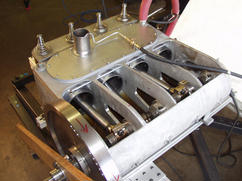
A replica of the 1903 Wright engine
–
their first aircraft motor
–
with the crankcase exposed.
|
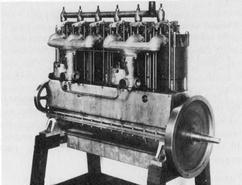
A late model Wright "6-60" six-cylinder engine, circa 1915. This was
one of the last engines produced by the Wight Company.
|
1903 Engine
– The gasoline engine that powered the first flights on December 17,
1903 delivered 12 hp when it was started, then dropped somewhat when the
motor heated up. It was built along a then-standard 4-4-4 design
– 4
cylinders, each 4 inches (10.2 cm) in diameter with a stroke of 4 inches
(10.2 cm). It had no spark plugs; each cylinder had electrical "points"
that sparked when they opened. This was called a "make-and-break"
ignition. The combined weight of the engine, water, and oil
was about 180 hundred pounds (81.6 kilograms).
|
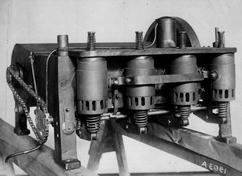
The 1903 Wright engine was a "horizontal" engine
– the pistons moved
horizontally in the cylinders. There was no carburetor; the Wrights
dripped fuel into the intake at the top of the engine.
|
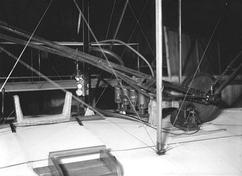
The 1903 Wright engine installed on the 1903 Wright Flyer. It was a
hot-running engine – the ignition chamber glowed a dull red after
the engine had been running for a few minutes, even with the
radiator connected.
|
1903
Propellers – The propellers that drove the 1903 Wright Flyer
through the air were the result of careful thought,
innovative mathematics, and combative arguing between Orville and
Wilbur. In the end, they agreed to treat their props as if they were
rotating wings. As such, the props had cambered blades to increase
thrust. After several experiments, the Wrights ended up with two
slow-turning (350 rpm) props 8.5 feet (2.6 meters) long. Each turned in a
different direction. This canceled out the sideways torque generated by
the spinning props.
|
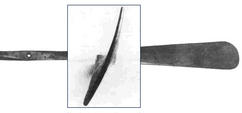
Two views of a 1903 Wright propeller. Note that the blade is cambered
–
it was designed as a wing
–
the camber produces lift in a horizontal
direction The design was remarkably efficient for its day,
converting 66% of the mechanical energy used to turn the props into
thrust.
|
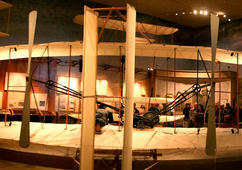
The propellers mounted on the 1903 Flyer now on display at the
Smithsonian Air & Space Museum.
|
1904-1905 Engines
– Upon returning from Kitty Hawk, the Wrights built two horizontal engines.
One of these they mounted on their 1904 and 1905 Flyers. The other was
an experimental "bench" engine, used to test ideas to improve power,
reliability, and cooling. The Wrights would modify the experimental
engine to investigate an idea, and then transfer that modification to
the airplane engine if it worked. In this way, they eventually boosted
the output of their engines to 25 hp.
|
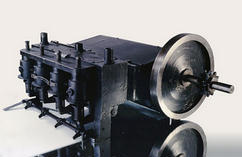
The 1904 experimental engine, also known as Wright Engine No. 3, is on
display at the
Dayton Engineer's Club in Dayton, Ohio.
|
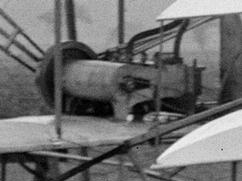
The 1904-05 airplane engine
–
Wright Engine No. 2
–
mounted on the
1904 Flyer. It was later cannibalized for parts when Orville restored
the 1903 Flyer in 1916.
|
1905-1915 Bent-End Propellers
– In 1904, the Wrights noticed their propeller blades had a tendency
the flex at flying speed, altering the angle at which
they met the air. This in turn reduced thrust. At first Will and
Orv tried prevent this by increasing the width of the blade, but this
worked only partially. They next added "little jokers"
– triangular
extensions – to the trailing
edges of the blades so that when the prop flexed at speed, the blades
would be at the proper shape and pitch. This did the trick and evolved into
a distinctive shape known as the
Wright "bent-end" propeller.
|
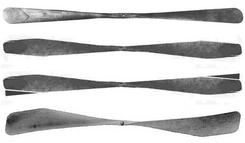
Wright propellers evolved through several designs from 1904 to 1905. The
end result was the distinctive "bent-end" propeller that revolved
between 400 and 500 rpm and was 78% efficient. By comparison, modern
propellers are 82-83% efficient.
|
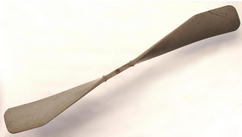
Bent-end propellers continued to be used on various Wright airplanes
that were manufactured through 1915. This particular prop was
designed to be used on the 1915 Model K, a large float plane the
Wrights built for the U.S. Navy.
|
1906-1912
Vertical 4-Cylinder Engine – In 1906, the Wrights designed a
vertical 4-cylinder engine for use on their commercial airplanes. It had
individual cylinders that could be disassembled one at a time to make
maintenance easier. It also had spark plugs and a high-tension magneto to make the ignition system
simpler and more reliable. The first Wright "vertical 4" engine produced 28 horsepower,
but later improvements boosted this to nearly 40 hp. In later years, the
engine was referred to as the "Wright 4-40"
– 4 cylinders, 40 hp.
|
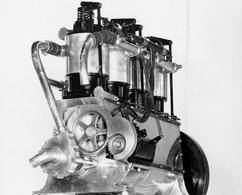
The Wright 4-40 also had a water pump (lower left) to increase cooling.
|
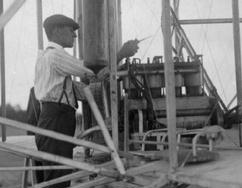
Wilbur lubricates a Wright vertical 4-cylinder engine in France in
1908. Although more powerful, the engine was actually slightly
lighter (180 lbs or 81.6 kg) than the Wrights' original horizontal-4
engines.
|
1911-1916
Vertical 6-Cylinder Engine –
As the need for more power and speed grew, the Wrights developed a
"straight six" engine
– six cylinders in a straight line.
This wasn't just a stretched 4-40, there were significant improvements
in the way the engine operated. This was the first of the Wright engines to employ standard
carburetion, giving it a range of speeds at which it could be operated.
Both the heads and the cylinders were water-cooled, so it ran much
cooler. And for the first time the exhaust was ported away from the engine (and
operator) through exhaust tubes. The enlarged and improved engine produced over 60
horsepower and was designated the "Wright 6-60."
|
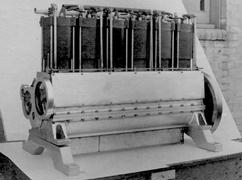
The Wright 6-60 was also the first Wright engine in which both the
intake and exhaust valves were operated by a camshaft. Previous Wright
engines had automatic (spring-operated) intake valves.
|
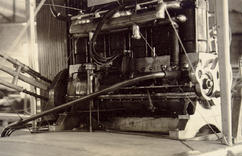
The Wright 6-60 was first used on the Wright Model C, an upgraded
version of the Model B. It proved to be too much engine for the
airplane, pushing it too fast. But later Wright airplanes with
stronger aerodynamic airframes –
particularly Models F, G, and H – seemed to grow into the engine.
|
|
|

